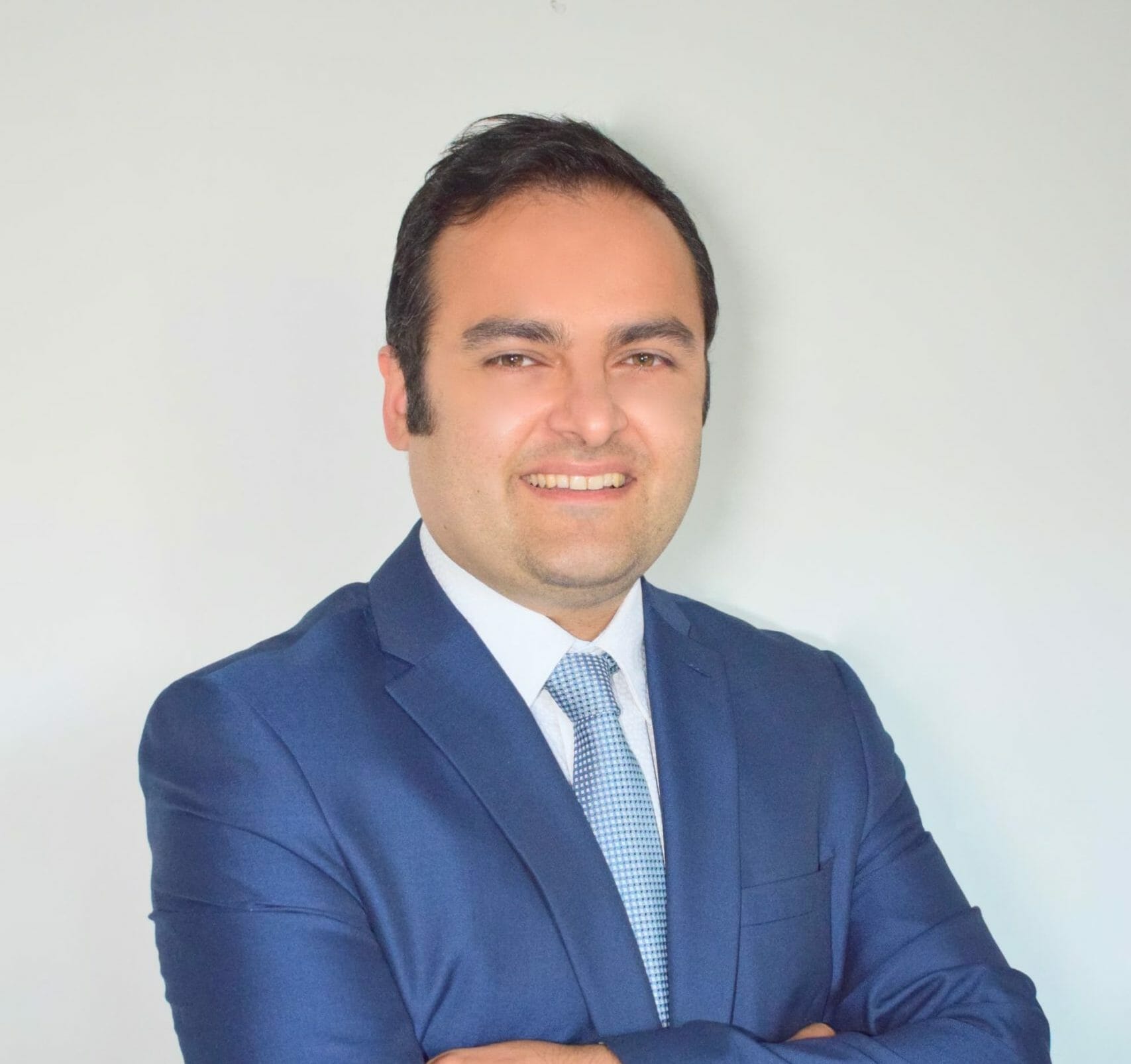DIEP flap reconstruction for breast cancer patients
Our DIEP flap reconstruction service is provided at the Royal Free Hospital in Hampstead.
We specialise in DIEP flap surgery, a procedure which is internationally recognised as the Gold Standard in autologous reconstruction. This advanced procedure uses your own tissue to create a breast that feels incredibly natural, with beautiful, permanent results and no foreign implants.
What is the DIEP flap?
There are two main types of breast reconstruction. Surgeons can use a ‘flap’ of your own tissues from elsewhere on your body, known as an autologous reconstruction, or use a breast implant to recreate the volume of the missing breast.
DIEP stands for deep inferior epigastric artery perforator flap. DIEP flap surgery involves taking tissue from the abdomen with its blood supply to reconstruct the breast. This is a long microsurgical procedure that can take up to six to eight hours.
Its advantages include replacing like with like tissues that have the same consistency and feel as your own breast tissue. Furthermore, the tissues will change as your body gains or loses weight. In contrast, a breast implant reconstruction may eventually need replacing as it is a foreign body. Tissue from the abdomen is taken and shaped into a breast. The blood vessels are attached to the blood vessels in the chest.

Our expert team, led by consultant plastic and reconstructive surgeons Mr Dariush Nikkhah and Mr Shadi Ghali, is the first centre in the entire United Kingdom to perform the revolutionary “minimal incision” DIEP flap approach.
This unique technique is a genuine game-changer in breast reconstruction. We routinely screen patients to see if they are suitable for this innovative approach.
The benefits include:
- Minimal internal sheath incision: An average cut of only 4cm, compared to the traditional standard of 10-12cm.
- Quicker recovery: Reduced risk of hernias means a smoother, faster return to normal life.
- Natural results: We still use your body’s own tissue from the lower abdomen for the most natural-feeling outcome.
Contact us Monday to Friday, 8am - 6pm:
Booking line: +44 (0) 20 4527 2993
How is a DIEP flap procedure performed?
This procedure usually involves two surgeons. A breast surgeon will remove your breast – a mastectomy – and a plastic surgeon will take excess tissue from your abdomen, preserving the muscle, to make the flap to reconstruct your new breast. In some cases, the blood supply from both sides of the abdomen can also be taken to make the flap, called a Bipedicled DIEP. This enables the use of the entire abdomen to reconstruct the breast, however usually just half or a portion of the abdomen is needed in most cases.
Following the removal of the flap, the abdomen is closed leaving a scar that extends from hip to hip but will be covered by underwear. If the DIEP flap muscle has not been taken with the blood supply, a mesh may be needed to support the abdominal wall. The mesh will support the abdominal wall’s integrity and reduce the risk of Hernia.
Step one: creating the DIEP flap from abdomen tissue

Tissue from the abdomen is marked for DIEP flap transfer.
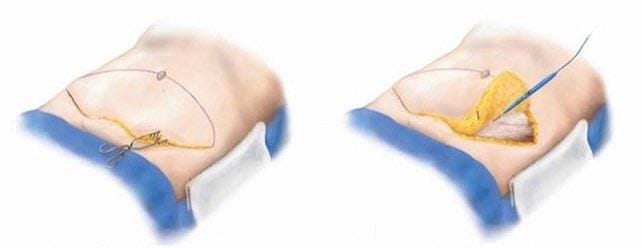
Skin is undermined to allow skin closure.

Step two: removing the DIEP flap from the abdomen

The blood supply to the DIEP flap is identified.

The blood vessels are traced through the muscle and divided. The DIEP flap can now be transferred to create a new breast.

Step three: closing the abdomen

The abdomen is closed, and a new belly button created.
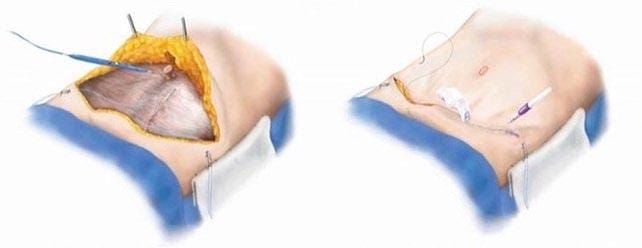
Step four: connecting the DIEP flap to your chest to create a new breast

The DIEP flap taken from the abdomen is shaped into a breast.

The blood vessels of the chest and DIEP flap are joined together under a microscope.

How is the DIEP flap connected to the chest to make a new breast?
Blood vessels in the chest, which transport blood throughout your body, are connected to the blood vessels from the DIEP flap using small stitches under a microscope. Often a small portion of your rib, about two to three cm, needs to be removed to access these internal mammary vessels in the chest.
What is the difference between delayed and immediate reconstruction?
You may prefer to have your mastectomy first and wait for your breast reconstruction. In many cases however the reconstruction can be done immediately with the mastectomy. The advantage of an immediate approach is that your own skin can preserved over the DIEP flap. The DIEP skin paddle is larger in the delayed group as the mastectomy skin flaps are not preserved. This difference in appearance is illustrated in the figure below on page.
Immediate mastectomy / reconstruction
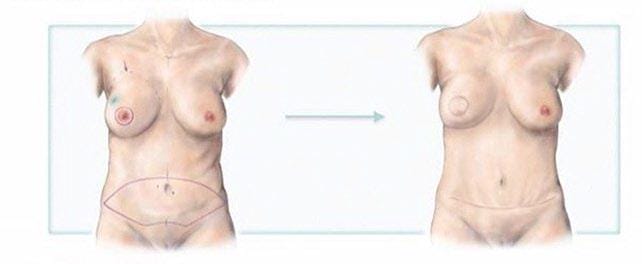
Delayed reconstruction
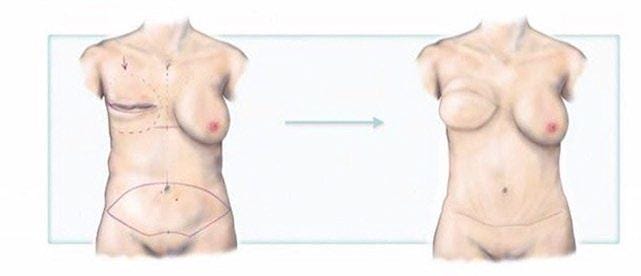
Who is ideal for a DIEP flap breast reconstruction?
To undergo a DIEP flap breast reconstruction you need to have sufficient abdominal tissue. Having had a C-section to give birth does not prevent you from having a DIEP flap. If you have previously had open or laparoscopic abdominal surgery, you will need to have a CT angiogram, a type of X-ray, to check if the blood vessels are present.
Studies have shown that for patients with a high BMI weight (above 30), there is a higher risk of complications with DIEP flap surgery. For example, the wound can break down and become infected. Occasionally, we do perform immediate reconstructions for patients with a BMI of up to 35 but you would be advised of the increased risk. If you have opted for a delayed reconstruction, we would advise you to achieve a BMI weight of less than 30.
What investigations do I need before I have a DIEP flap?
You will need to have some routine blood tests and a CT scan of your abdomen to check whether you have an adequate blood supply for the DIEP flap.
Can I have a DIEP reconstruction while undergoing chemotherapy?
We usually wait four to six weeks after chemotherapy has finished before performing a mastectomy and DIEP breast reconstruction.
When can I have delayed DIEP reconstruction after radiotherapy?
You will usually have to wait for around 12 months after radiotherapy for a DIEP breast reconstruction as evidence points to lower complications and flap failure rates.
What is the in-patient stay like for a DIEP procedure?
Your in-patient stay can be up to five days but in many cases you may be well enough to go home after three days.
On the first night after your operation, the DIEP flap breast reconstruction is checked frequently. This can often be the most sleepless and difficult night. After 48 hours, these checks are less frequent.
On the second day, most patients will have their urinary catheters removed. This is a tube used to empty the bladder into a bag. You are also likely to be sitting up out of bed and able to walk around the ward. Small plastic tubes placed underneath the skin of the abdomen where the surgery was performed, called pain catheters, are used to relieve pain, and are usually kept in for 48 hours.
What can you expect after DIEP reconstruction?
DIEP breast reconstruction is the biggest operation you will undergo in the journey to rebuild your breast after cancer. Depending on what you want in terms of size, we often try to match the new breast with the existing one. This sometimes is not possible and smaller secondary procedures are needed.
Patients will often need a second operation to reduce and lift the existing breast, called a breast reduction or mastopexy. If there are any irregularities in the shape of the reconstructed breast, these can also be addressed in smaller operations.
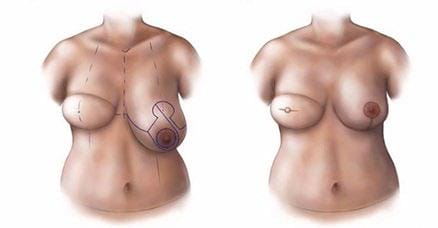
Illustration above shows patient has had a left breast uplift to match her right DIEP reconstruction.
What are the complications after DIEP reconstruction?
There is a one to four per cent risk of total failure of the reconstruction; this is usually due to a blockage in the blood vessels that are connected to the chest. This risk is increased in patients with a high BMI weight. There are also risks of infection, wound breakdown at the breast and abdomen and poor scarring.
Some patients will need to go back to theatre in the acute period for any of these risks and also if there is compromised blood supply of the DIEP flap. In rare cases you may get an abdominal bulge called a hernia due to a weakness in the abdominal wall. If troublesome it may require surgery.
Can I get my nipple reconstructed?
Nipple reconstruction can be performed as the final stage of the breast reconstruction journey after your DIEP flap surgery. A new nipple can be made from local tissues over the DIEP flap under a local anesthetic. Once the new nipple has healed the areola, the small circular area around the nipple, can be tattooed to match the existing breast. If the colour fades, this procedure can be repeated.
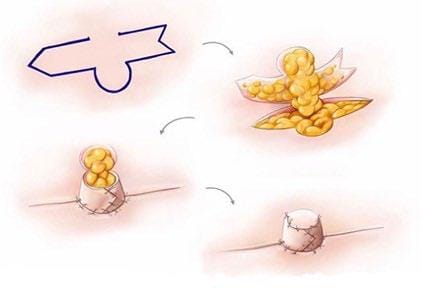
Illustration above shows how skin is reshaped to make a new nipple.
After your surgery
Sports Bras and pants
It is essential that a non-wired high impact sports bra is worn on discharge from hospital and for at least six weeks after surgery. This is to ensure that your reconstructed breast (s) is (are) supported whilst healing. Any leading department store and some supermarkets will sell this type of bra. We recommend front fastening or back fastening bras. High waisted support pants/Abdominal binder will be needed if you have had surgery to your abdomen. Cycling shorts will be needed if you have had surgery to your thighs. This will give you support and aid comfort, both helpful in assisting with your recovery. There may be a degree of asymmetry between your reconstructed breast and your other breast. If this is the case the CNS can offer you a prosthesis ‘softee/comfee’ with your sports bra which can help, make your breasts appear more even in a bra.
Follow Up Appointments
You will be reviewed in our nurse led dressing clinic either at the Royal Free hospital or Mount Vernon for a minimum of two appointments, a week apart. A follow-up with your consultant will be six to eight weeks post-surgery.
Pain relief
It is important that you take the pain relief medication as prescribed. You will be given a 14-day supply of medication on discharge home. If pain persists, then we recommend you see your GP for further prescriptions.
Further surgery
It will take at least three months for your reconstructed breast(s) to settle into their final shape. Some ladies may experience some tightness in their reconstructed breast. Once the surgeon feels that the healing stage has completed; you can discuss any concerns you have about the outcome following your breast reconstruction. Occasionally, some surgical adjustments are made to help with symmetry and to perform a nipple reconstruction.
For further information, you can download this as a fact sheet here.
Why choose the Royal Free London for your breast reconstruction surgery
Our private plastic and reconstructive surgery are one of the major surgical disciplines at the Royal Free London NHS Foundation Trust. At the heart of the service is dedication and commitment to continuous improvement while also embracing the latest advances and technologies. We are supported by prestigious and world renowned consultant plastic and reconstructive surgeons who are also active in research and clinical trials. Our collective aim for patients recovering from cancer is to provide holistic end-to-end care, from diagnostics to treatments, with a focus on improving patient outcomes and quality of life.
Our multidisciplinary team at the Royal Free London Private Patients Unit ensures every patient receives a thorough assessment and personalised guidance. Your consultation is designed to make you feel informed, confident, and empowered in your recovery journey.
Meet our consultants
We work with leading experts who are all supported by the expertise of a multidisciplinary team. Our specialist team of doctors and surgeons includes:
Royal Free Hospital, Hampstead
The Private Patients Unit at the Royal Free Hospital is part of the NHS and is wholly owned by the Royal Free London NHS Foundation Trust. We offer you access to some of London’s most experienced specialists, all of whom work as NHS consultants at our facilities.

Funding your treatment
We are committed to providing care to all patients which is why we accept self-paying and private medical insurance.
Learn more about funding your treatment.
Patient information leaflets
We provide all our patients with the information they need to support their health and understand the treatments and services we offer.
Read our patient information leaflets for more information.
Investing in the NHS
The NHS is an important part of what we do at Royal Free London which is why we reinvest our profits back into it. Our investment provides life-saving equipment and supports medical research to ensure better healthcare for all.

